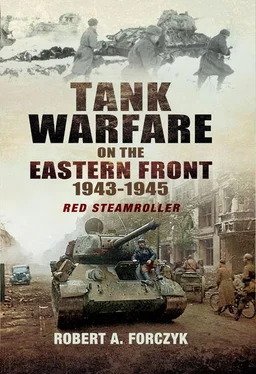Operation Zitadelle : The Southern Front, 5–16 July 1943
Von Manstein had wanted to attack the Kursk Salient as an immediate follow up to his successful Backhand Blow counter-offensive, but was stymied first by the rainy spring weather, and then by Hitler’s repeated delays of Zitadelle to await the arrival of the Panther medium tank and more Tigers. Although the point has often been made that an earlier German attack might have succeeded, this punditry disregards the weather, the logistic situation and the emaciated state of Hoth’s 4.Panzerarmee. The simple fact is that the Red Army used the April–June lull better than the Wehrmacht did, fortifying the Kursk salient and forming a large mobile reserve for follow-on operations. Soviet intelligence about the Zitadelle plan was excellent, in part due to information forward from the Allied ULTRA signals intercept programme. [21]In contrast, the Germans knew about the Soviet defensive preparations in the Kursk salient due to regular photo reconnaissance, but they were unaware of the vast numbers of RVGK reserves that were being concentrated further to the rear. Von Manstein’s hubris about slicing through the Soviet defences with his armoured battering ram was based on ignorance of the enemy’s actual strength.
In planning Zitadelle , von Manstein displayed a certain inattention to details that would plague the operation from the start. Unlike Model, he failed to appreciate the depth of Soviet minefields and asked for no special engineering resources; Hoth’s 4.Panzerarmee (PzAOK 4) received no Goliath or BIV demolition vehicles or other mine-clearing equipment. Von Manstein’s operational plan was very basic, envisioning that Hoth’s 4.Panzerarmee, consisting of General der Panzertruppe Otto von Knobelsdorff’s XXXXVIII Panzerkorps (3., 11.Panzer-Divisionen and the Großdeutschland ) and Hausser’s II. SS-Panzerkorps ( LSSAH , Das Reich and Totenkopf ) would form the main effort, while Armee-Abteilung Kempf would conduct a supporting attack with General der Panzertruppe Hermann Breith’s III Panzerkorps (6., 7. and 19.Panzer-Divisionen) and Generaloberst Erhard Raus’ XI Armeekorps (two infantry divisions and Sturmgeschütz-Abteilung 905). Von Manstein believed that this mass of armour and troops, with over 1,500 AFVs and supported by Luftflotte 4, could blast its way through any defensive lines. Up front though, von Manstein violated the principle of unity of command by putting two Panzerkorps under Hoth and one under Kempf, when doctrine recommended that all three should have been under a single army commander. Consequently, Breith’s III Panzerkorps contributed little to its primary mission of protecting the right flank of II. SS-Panzerkorps and essentially fought an isolated and operationally pointless battle. Nor did von Manstein ensure that his subordinates had conducted detailed tactical planning prior to execution, which became immediately obvious in both the III. and XXXXVIII Panzerkorps sectors. Finally, von Manstein’s broad front implementation of Zitadelle left him with no operational-level reserves, other than General der Panzertruppe Walther Nehring’s distant and under-resourced XXIV Panzerkorps. After the war, von Manstein would claim that Nehring’s corps could have made a great impact upon the outcome of Zitadelle , but this formation had a total of only 171 tanks among its three mechanized divisions. Furthermore, Nehring’s XXIV Panzerkorps was the only mobile reserve belonging to the 1. Panzerarmee and stripping this resource would seriously weaken Heeresgruppe Süd’s right flank.
Facing Hoth’s 4.Panzerarmee, Vatutin had arrayed his Voronezh Front forces in great depth. General-leytenant Ivan M. Chistiakov’s 6th Guards Army (6 GA) was deployed in a two-up/one-back style echeloned defence across a 60km-wide front, with the 22nd Guards Rifle Corps (22 GRC) opposite XXXXVIII Panzerkorps and the 23rd Guards Rifle Corps (23 GRC) opposite the II. SS-Panzerkorps. In tactical reserve, Chistiakov had the 96th Tank Brigade (46 T-34s and 5 T-70) and the 230th and 245th separate tank regiments with a total of 34 M3 Grants and 44 M3 Stuarts. More importantly, Chistiakov had the 27th and 28th Anti-tank Brigades in general support, plus 10 separate anti-tank regiments which were attached to his rifle divisions, providing 6 GA with a total of 573 anti-tank guns. {86} However, Chistiakov’s sector only had half the density of mines that Pukhov’s 13th Army had on the northern front and, unlike Rokossovsky, Vatutin had not deployed an artillery corps to support the main defence. With fewer mines and less artillery support, Chistiakov’s front was not as dense a defence as Model had confronted in the north.
Behind Chistiakov’s 6 GA, Vatutin deployed the 69th Army in a third line of defence with five rifle divisions, the 35th Guards Rifle corps and General-leytenant Mikhail E. Katukov’s 1st Tank Army, comprised of the 6th and 31st Tank Corps and 3rd Mechanized Corps. Altogether, Katukov had 587 tanks of which 484 were T-34s – an unusually high proportion of medium tanks for the Red Army in mid-1943. Vatutin kept two more tank units, the 2nd and 5th Guards Tank Corps with a total of 410 tanks, under his control in front reserve. Vatutin’s intent was to use Katukov’s armour and the two separate tank corps to mount local counter-attacks to block any German breakthroughs, rather than as a masse de manoeuvre . General-leytenant Mikhail S. Shumilov’s 7th Guards Army (7 GA) opposed Armee-Abteilung Kempf with the 25th Guards Rifle Corps in a 2-up/1-back defensive echelon, supported by two tank regiments with 33 T-34 and 22 KV-1s.
The long-awaited Panther tanks arrived by rail near Borisovka, beginning on 1 July, and the last trainload did not arrive until 4 July, the day before Zitadelle was to begin. All the technical problems aside, Hoth had made little effort to ensure that the two Panther-Abteilungen had proper command and control or were integrated into PzAOK 4’s tactical plans. The 10.Panzer-Brigade was established in Berlin on 27 June under Oberst Karl Decker to command the Panthers, but the headquarters did not even begin moving to the Eastern Front until 3 July. [22]This mistake was another indicator that the efficiency of the German Panzertruppen was slipping by 1943. Realizing that someone had dropped the ball, Major Meinrad von Lauchert, who had been involved with training Panther crews at Grafenwöhr, formed the provisional Panzer-Regiment 39 to control the Panthers arriving at the Borisovka railhead. The Panthers were put under the operational control of Großdeutschland , which gave von Lauchert a radio command vehicle and enough resources to operate a small tactical command post. However, this ad hoc solution all occurred in the last evening before Zitadelle began, which meant that coordination and the tactical orders process were curtailed. One-third of the Panther crews had no combat experience and now they were being asked to go into battle attached to an unfamiliar unit and with vague tactical orders. Making matters significantly worse, there was no opportunity at the railhead to bore-sight the main guns (which after a long, bumpy train ride would definitely be out of alignment with the gunner’s sights) or to set radios to correct frequencies. As soon as they left the railhead, Panthers began breaking down on the 35km road march to the assembly area near Tomarovka and by the time they reached it, only 166 out of 204 Panthers were still running. {87} Two Panthers were completely burnt-out by engine fires. [23]
While the Panthers were moving up to the front, Hoth’s PzAOK 4 was already making its initial moves in Zitadelle . At 1450 hours on 4 July, Stukas from Luftflotte 4 conducted a massive airstrike against positions in the 6 GA’s forward security zone, followed by an artillery bombardment from XXXXVIII Panzerkorps. Hard on the heels of the artillery barrage, infantrymen from both corps began an aggressive counter-reconnaissance probe to overrun Soviet units in their forward security sector. Most of the action involved battalion-size probes to eliminate Soviet artillery observation posts and to begin clearing the outer minefields. No tanks were involved in this effort, but assault guns and reconnaissance vehicles moved forward. In contrast to von Knobelsdorff’s broad daylight approach, Hausser’s II.SS-Panzerkorps did not begin its own counter-reconnaissance effort until after dusk. Hoth’s troops succeeded in capturing a few villages and hilltops, but were shocked by the difficulty of clearing paths through the minefields and the heavy casualties. Nor were all the Soviet outpost positions or mines eliminated in the security zone. {88}
Читать дальше








![John Stieber - Against the Odds - Survival on the Russian Front 1944-1945 [2nd Edition]](/books/405234/john-stieber-against-the-odds-survival-on-the-russian-front-1944-1945-2nd-edition-thumb.webp)



